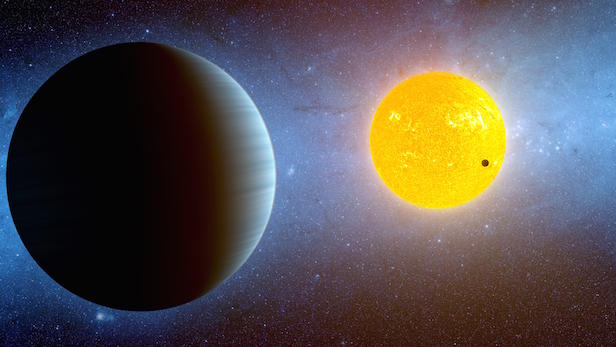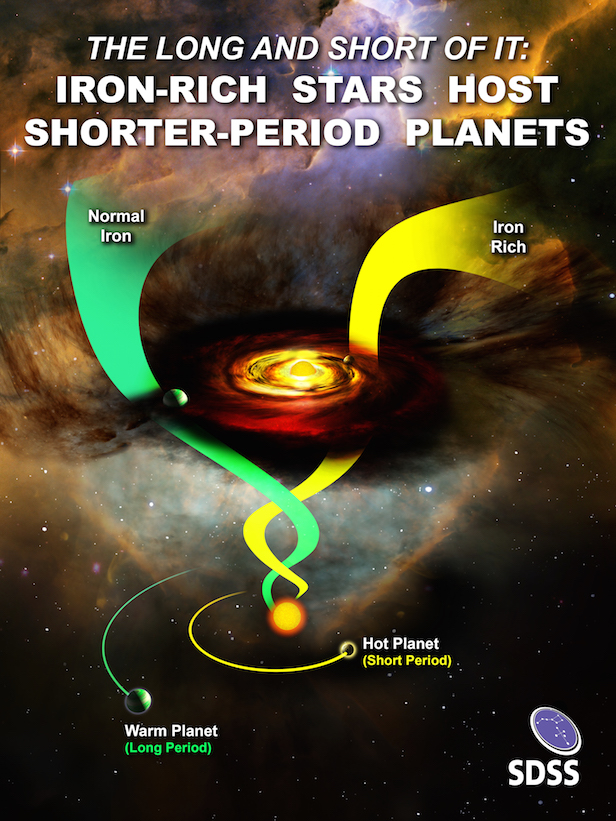Exoplanets found to orbit iron-rich stars tightly
A new study has shown that alien worlds tend to have shorter orbital periods when swinging around their metal-rich stellar parents

Stars consist mostly of hydrogen, but their iron content differ dependent on their age. Image credit: NASA/Ames/JPL-Caltech
By combining exoplanet orbital information with stellar composition analysis, astronomers have deduced there is a relationship between iron-rich stars and short-period exoplanet orbits. The data collected by NASA’s Kepler spacecraft and the Sloan Digital Sky Survey (SDSS) was essential in this discovery, which will help further our understanding of how planets beyond our Solar System from around different stars.
“Without these detailed and accurate measurements of the iron content of stars, we could have never made this measurement,” says Robert Wilson, a graduate student in astronomy at the University of Virginia.
Using SDSS data, the team of astronomers discovered that stars containing higher concentrations of iron will most likely host planets that orbit closer to them. These planets have shown to orbit their host planet once every eight days or less. On the contrary, stars with less iron host planets with longer orbital periods, meaning are much further away from the star. Further investigation will help us fully understand the variety of extrasolar planetary systems in our galaxy, and how they form and evolve.
The first exoplanet was discovered in 1995 orbiting a main sequence star 50 light years away from us. The discovery of this world, known as 51 Pegasi b, was the start of a revolution in astronomy. Exoplanets became the subject of much attention for many astronomers, and this took a giant leap forward in 2009 when NASA’s Kepler spacecraft was launched. Kepler was designed to measure the brightness of multiple stars at the same time, watching out for a periodic dimming associated with a planet passing in front of its host star. The time between the measured dimming told astronomers what its orbital period was, and therefore how far away the planet is from the star. Thanks to Kepler, to number of exoplanets with known orbital periods went from 400 in 2009 to more than 3,000 today.
As for the chemical composition of these host stars, Kepler did not conduct this analysis. This was done by the SDSS and its Apache Point Observatory Galactic Evolution Experiment (APOGEE), which studied hundreds of thousands of stars all over the Milky Way galaxy.
When a star’s light travels to us, we can split the light into its fundamental colours, like when white light passes through a prism. Although, different elements within the star can absorb light as specific wavelengths, blocking out certain colours, which is shown as a spectrum. This is how APOGEE measured the different elements of these stars from their spectrum, and in particular their iron abundance.
“All Sun-like stars are mostly hydrogen, but some contain more iron than others,” says Johanna Teske of the Carnegie Institution for Science. “The amount of iron a star contains is an important clue to how it formed and how it will evolve over its lifetime.”

How much iron is within the star appears to be related to how close the exoplanet is to its host star. Image credit: D. Berry/SkyWorks Digital Inc./SDSS
Combining the APOGEE and Kepler data is what lead this team of astronomers to finding the relationship between iron-rich stars and their planetary system. “We knew that the element enrichment of a star would matter for its own evolution, but we were surprised to learn that it matters for the evolution of its planetary system as well,” says Teske.
This study is the result of previous work done by Gijs Mulders of the University of Arizona. Mulders and the rest of the team used a larger, but less precise, sample of spectra from the Large-Area Multi-Object fibre Spectroscopic Telescope (LAMOST)-Kepler project. The LAMOST-Kepler project yielded similar trends about the iron-rich stars with closer-in planet, but they couldn’t confine the critical period of eight days.
“It is encouraging to see an independent confirmation of the trend we found in 2016,” says Mulders. “The identification of the critical period really shows that Kepler is the gift that keeps on giving.”
Wilson also says that a surprising aspect of the result was that the iron-enriched stars have only 25 per cent more iron than others in the sample. “That’s like adding five-eighths of a teaspoon of salt into a cupcake recipe that calls for half a teaspoon of salt, among all its other ingredients. I’d still eat that cupcake,” Wilson says. “That really shows us how even small differences in stellar composition can have profound impacts on planetary systems.”
This work still doesn’t answer some of the major questions surrounding exoplanets, and in particularly the Earth-sized or larger “super-Earths” exoplanets. We still don’t how these planets form closer to iron-rich stars. Or it could be the case that they form further out from the star and migrate inwards during it’s evolution? Because of these queries, Wilson and collaborators hope to create new models of protoplanetary discs to test this.
“I’m excited that we still have much to learn about how the chemical compositions of stars impact their planets, particularly about how small planets form,” Teske says. “Plus, APOGEE provides many more stellar chemical abundances besides iron, so there are likely other trends buried within this rich dataset that we have yet to explore.”
Keep up to date with the latest reviews in All About Space – available every month for just £4.99. Alternatively you can subscribe here for a fraction of the price!




